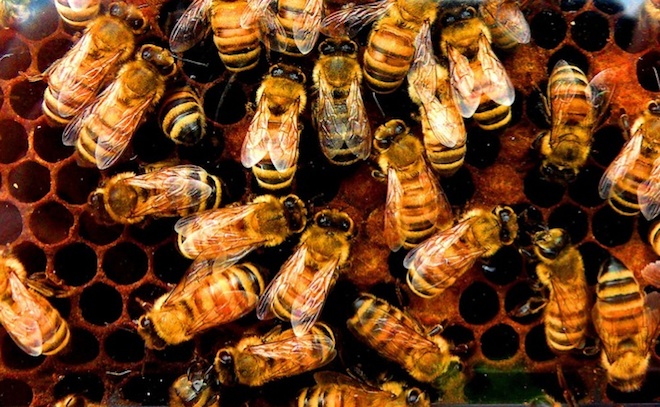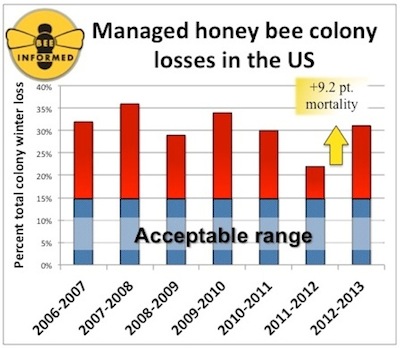
© Jennifer C/Flickr
Nearly one in three commercial honeybee colonies in the United States died or disappeared last winter,
an unsustainable decline that threatens the nation's food supply.Multiple factors - pesticides, fungicides, parasites, viruses and malnutrition - are believed to cause the losses, which were officially announced today by a consortium of academic researchers, beekeepers and Department of Agriculture scientists.
"We're getting closer and closer to the point where we don't have enough bees in this country to meet pollination demands," said entomologist Dennis vanEngelstorp of the University of Maryland, who led the survey documenting the declines.
Beekeepers lost 31 percent of their colonies in late 2012 and early 2013, roughly double what's considered acceptable attrition through natural causes. The losses are in keeping with rates documented since 2006, when beekeeper concerns prompted the first nationwide survey of honeybee health. Hopes raised by drop in rates of loss to 22 percent in 2011-2012 were wiped out by the new numbers.

© Engelstorp et al.Honeybee colony losses over the last seven years
The honeybee shortage nearly came to a head in March in California, when there were barely enough bees to pollinate the almond crop.
Had the weather not been ideal, the almonds would have gone unpollinated - a taste, as it were, of a future in which honeybee problems are not solved.
"If we want to grow fruits and nuts and berries, this is important," said vanEngelstorp. "One in every three bites [of food consumed in the U.S.] is directly or indirectly pollinated by bees."
Scientists have raced to explain the losses, which fall into different categories. Some result from what's called colony collapse disorder, a malady first reported in 2006 in which honeybees abandon their hives and vanish. Colony collapse disorder, or CCD, subsequently became a public shorthand for describing bee calamities.
Most losses reported in the latest survey, however, don't actually fit the CCD profile. And though CCD is largely undocumented in western Europe, honeybee losses there have also been dramatic. In fact, CCD seems to be declining, even as total losses mount. The honeybees are simply dying."Even if CCD went away, we'd still have tremendous losses," said entomologist Diana Cox-Foster at Pennsylvania State University. "CCD losses are like the straw that breaks the camel's back. The system has many other issues."
Studying these issues isn't easy. In real-world agricultural settings, it's hard to run the rigorous, every-last-variable-controlled experiments on which definitive conclusions are founded. These experiments can be run in labs and small-scale test fields, but whether those accurately reflect real-world complexity is debated.
Amidst the uncertainties, scientific attention has settled on a group of culprits, the most high-profile of which is a class of pesticides known as neonicotinoids. These were developed in the 1990s, rushed to market with minimal studies of potential harms, and subsequently became the world's most-used pesticides.
In the last several years, it's become evident that neonicotinoids are extremely toxic to honeybees and, even in small, sub-lethal doses, make bees more vulnerable to disease. The European Union recently limited neonicotinoid use, and the U.S. Environmental Protection Agency is reviewing their use.
Pesticide companies have fought the restrictions, arguing that neonicotinoids are unfairly blamed. Most non-industry scientists say the question isn't whether neonicotinoids are a problem, but where they fit into a constellation of problems.
"Different studies indicate that this class of pesticide is rather harmful to the bees," said honeybee pathologist Cédric Alaux of the French National Institute for Agricultural Research, who said the E.U.'s restrictions are sensible. "However, we should not be too naive and think that it will solve the bee problem."
Just as important as neonicotinoids, and perhaps more so, are Varroa destructor mites. First detected in the United States in 1987, the mites weaken bees by sucking their hemolyph, the insect analogue of blood, and also transmit viruses and other parasites. A recent USDA report called Varroa "the single most detrimental pest of honey bees."
The report also noted that neonicotinoid exposure alters immune system function in Varroa-infected bees and makes bees more vulnerable to infection by Nosema ceranae, another parasite implicated in honeybee losses. It's possible that neonicotinoids used on crops don't usually kill bees outright, but weaken them enough for other stresses to become lethal.
Agricultural entomologist Christian Krupke of Purdue University likened the effects to "living in an area with extreme levels of smog, causing your body and immune system to become overtaxed so that a common cold progresses to pneumonia."
Krupke noted that although neonicotinoids are the most common poisonous chemicals in honeybee environments, they're far from the only chemicals. Cox-Foster and vanEngelstorp stressed that point, referencing research that found 121 different pesticides in honeybee hives. On average, each hive contained traces of 6 pesticides, and sometimes several dozen.
Research on pesticide interactions is in its infancy, but combinations may be extremely harmful to bees, amplifying what the chemicals would do alone. "I worry that the neonicotinoid attention is distracting from the other pesticides that have clear effects, and might even have stronger effects. Things like fungicides are completely unregulated for bees," said vanEngelstorp. "I think we need to keep the pesticide investigation broader."
Another, less-appreciated aspect of honeybee life also gained attention in the winter survey and new USDA report: what they eat. Though commercial bees are trucked on pollination circuits around the United States, most beekeepers have home bases in the upper Midwest, an area that's undergone significant changes in recent years.
Rising food prices led farmers to plant crops in fields previously considered marginal or set aside as grasslands. Honeybees forage in those grasslands, and can't get the nutrition they need from flowering crops alone.
Add the record-setting drought of summer 2012, and bees were hard-pressed for nourishment. Malnourishment could in turn make bees more vulnerable to pests and infections, or exacerbate the effects of pesticides.
"The drought, the possible combination of factors that went with it, was clearly a big problem for a lot of beekeepers," vanEngelstorp said. "In some cases, it was a combination of Varroa and these malnourished, pesticide-exposed bees."
Commercial bees pollinate dozens of crops, and though colonies can be replaced, continuing losses could soon render beekeeping economically unviable. Researchers are trying to breed more resilient bees, but the combination of chemicals, nutrition and disease will likely prove insurmountable by genetic improvements alone, said Cox-Foster.
She said native pollinator habitat needs to be left intact or re-established; a field that goes unplanted, or a roadside left unmowed, can be thought of as insurance against commercial honeybee loss. Dennis vanEngelstorp recommended that, as a rule of thumb, 10 percent of land mass should be managed as pollinator havens.
Pesticides can also be used more carefully. Rather than being applied broadly, across entire fields and locales, they can be precisely targeted to outbreaks. Other unnecessary uses can be averted.
"Many entomologists and pest management professionals have been saying for years that there is no pest management justification for using these insecticides on virtually every crop grown in North America," said Krupke. "Yet, the opposite trend is occurring."
The honeybee catastrophe could also signal problems in other pollinator species, such as bumblebees and butterflies, that are not often studied."Thinking of honeybees as our canary in the coal mine, a monitor for environmental conditions, is very appropriate,"Cox-Foster said. "With honeybee colonies, you have the ability to open them up and see what's going on. There are many other species needed for pollination, but with most of those, we don't have the ability to see what's happening."
Update 5/9: Francesco Nazzi, an entomologist at Italy's University of Udine who studies the interactions of pests, parasites and honeybee immune systems, said he feels neonicotinoid pesticides "are not the major cause of widespread colony losses but one of many different causes, whose incidence may vary according to the local situation."
Nazzi pointed to surveys of honeybee losses in Canada, China, Israel, Turkey and western Europe, which have varied widely by locale and circumstance, with no clear explanation. In the European Union, where neonicotinoid use will be decreased but not eliminated for the next two years, Nazzi does not expect to see any clear, black-and-white effect.
Evidence about potential neonicotinoid harm, though, is "convincing enough to suggest caution," he said. "One may say that a broader ban may not be sufficient on its own to 'save' the bees, but it could help." Nazzi said the crucial question is whether neonicotinoid is even needed. "At least in Italy, in most cases, their use is actually unnecessary," he said.
One could guess that while growers are whining about the shortage of available honey bees to pollinate the cash crops, they are also spraying with the neonicotinoid pesticide that is killing the bees.